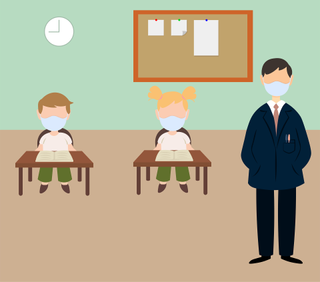The lessons we’ve learned about COVID mitigation two years into the pandemic still apply, even with the Omicron variant.
“Omicron requires us to bolster, but not reinvent, our existing approaches for teachers and staff,” says Dr. Sara B. Johnson, an associate professor of pediatrics at the Johns Hopkins University School of Medicine and co-director of the Rales Center for the Integration of Health and Education and the Johns Hopkins Consortium for School-Based Health Solutions. “What worked before works now, fortunately, but we need to update some strategies because of the greater transmissibility of this variant.”
Even though many of us know COVID mitigation best practices at this point, we’re still likely to make mistakes. It’s human nature, says Dr. Marney White, a psychologist and epidemiology professor at the Yale School of Public Health.
“We are very bad at evaluating personal risk and evaluating the risk that our various behaviors have on our health and our lifespan,” she says. “If people were able to accurately appraise risk, nobody would smoke, nobody would speed, everyone would wear a seat belt.”
In addition to getting vaccinated and boosted in accordance with CDC guidelines, here’s a reminder of some common but potentially risky behaviors to avoid.
1. Relaxing During Meal Times
“Meal times are a particular risk because students are unmasked and also because meals are often a chance to catch up and chat with others for students and adults,” Johnson says. “Eating with others, drinking, and congregating in small spaces are still riskier activities. Whenever possible, create space from others when eating and replace your mask when you’re not actively eating or drinking. In climates where it’s possible, eating outside is still great.”
White says, “Educators can reduce this risk by eating alone or at a far distance from any students or colleagues. If they must perform lunch duty, they should be sure to remain masked and try to stand at least 6 feet away from anyone who is not wearing a mask.”
2. Not Masking Properly
“For teachers in settings where many others are unmasked, it’s particularly helpful to use strategies like double masking; if possible, wearing a KN95, KN94 or N95 may provide additional protection above a basic cloth mask,” Johnson says. She adds the mask should fit tightly over the mouth and nose. “Because there are a lot of counterfeit masks out there right now, use the lists assembled by the CDC and FDA to identify authorized mask manufacturers. If possible, try out a few different styles to see which one is more comfortable and secure.”
White would prefer everyone be masked, but notes one-way masking can help. “While imperfect, wearing a mask and staying at least 6 feet away from others will decrease personal risk,” she says, pointing to Mayo Clinic research that provides evidence of effectiveness for one-way masking.
3. Gathering With Colleagues
CDC research last year suggested that educators may often play a significant role when the virus does spread in schools.
Johnson says before work each morning educators should mentally walk through the day and flag potential risk. “In the morning, are people gathering around the copy machine? Are they stopping to chat with colleagues in the hallways on their way to the parking lot after school?”
She adds, “I think there is broad awareness of what increases transmission risk, but we all need reminders to map out potential risk points and proactively avoid them. It can be hard not to fall into old habits without realizing it.”
4. Forgetting About Proper Ventilation Protocols
“There’s a tendency to be lax in our controls,” Dr. Joseph G. Allen, director of the Healthy Buildings Program at Harvard University’s T.H. Chan School of Public Health told us last year. “I’ve toured some schools where the policy was to keep windows open, even a couple of inches, and the windows are closed. Or in a school that has a portable air cleaner with a HEPA filter, which is a terrific strategy, they're running them on half-speed, or they tuck them away in the corner.”
A half-speed filter is going to be half as effective, and positioning it in a corner will limit its capabilities as well, says Allen, the chair of The Lancet’s Covid-19 Commission Task Force on Safe Work, Safe Schools, and Safe Travel. “If you're gonna have a portable air cleaner in the room, try to move it out from the corner. It doesn't have to be the exact center of the room but should be running at full speed. More windows open is better, even if cracked a few inches.”
5. Thinking Schools are Safer Than They Are
Because spread of the virus at schools has been relatively limited, White says that some have gotten the impression they are somehow unique spaces.
“It almost seems as if some people have interpreted it to mean there's some kind of magical force field around schools and that is not the case,” she says. “Schools are an indoor environment. They are currently considered relatively safe because they have been so careful about enforcing the mitigation strategies.”
To help prevent spread at schools, White suggests providing basic health education to children. “In the same way that we teach children to take turns, not to cut in line, and to raise their hand before speaking, teaching children about respecting their fellow human beings' physical safety is appropriate,” she says. “Young children can be taught basic disease prevention strategies, such as hand washing, as well as the importance of wearing masks to help protect themselves and their peers.”


